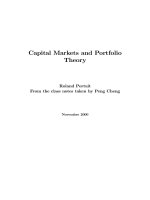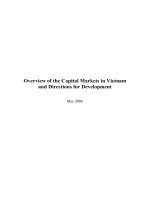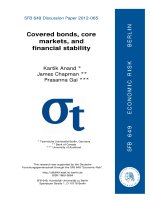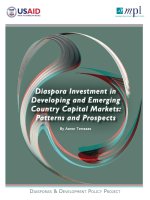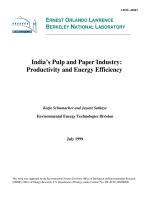Paper tigers chinese and india capital markets
Bạn đang xem bản rút gọn của tài liệu. Xem và tải ngay bản đầy đủ của tài liệu tại đây (1.46 MB, 12 trang )
Deutsche Asset
& Wealth Management
www.DeAWM.com
S6
SPECIAL ISSUE
Paper tigers: Chinese and Indian
capital markets
June 2014
Global Financial Institute
Your entry to in-depth
knowledge in finance
Dr. Paul Kielstra
2 Paper tigers: Chinese and Indian capital markets
Global Financial Institute
Introduction to “Global Capital Markets in 2030“
Deutsche Asset & Wealth Management’s Global
markets face weakening demand in many mature
Financial Institute asked the Economist Intelli-
markets.
gence Unit to produce a series of white papers,
custom articles, and info-graphics focused spe-
In short, while the world’s stock of financial assets
cifically on global capital market trends in 2030.
(e.g.
stocks,
bonds,
currency
and
commodity
futures) is growing, the pattern of that growth sugWhile overall growth has resumed, and the
gests that major shifts lie ahead in the shape of capi-
value traded on capital markets is astoundingly
tal markets.
large (the world’s financial stock grew to $212
trillion by the end of 2010, according to McKin-
This series of studies by Global Financial Institute
sey & Company) since the global financial crisis
and the Economist Intelligence Unit aims to offer
of 2008, the new growth has been driven mainly
deep insights into the long term future of capital
by
and
markets. It will employ both secondary and primary
by a $4.4 trillion increase in sovereign debt in
research, based on surveys and interviews with
2010. The trends are clear: Emerging markets,
leading institutional investors, corporate executives,
particularly in Asia, are driving capital-raising; in
bankers, academics, regulators, and others who will
many places debt markets are fragile due to the
influence the future of capital markets.
expansion
in
developing
economies,
large component of government debt; and stock
3 Paper tigers: Chinese and Indian capital markets
Global Financial Institute
Introduction to Global Financial Institute
Global Financial Institute was launched in Novem-
institutions are hundreds of years old, the per-
ber 2011. It is a new-concept think tank that seeks
fect place to go to for long-term insight into the
to foster a unique category of thought leadership
global economy. Furthermore, in order to present
for professional and individual investors by effec-
a well-balanced perspective, the publications span
tively and tastefully combining the perspectives of
a wide variety of academic fields from macroeco-
two worlds: the world of investing and the world
nomics and finance to sociology. Deutsche Asset
of academia. While primarily targeting an audi-
& Wealth Management invites you to check the
ence within the international fund investor com-
Global
munity,
publications
white papers, interviews, videos, podcasts, and
are nonetheless highly relevant to anyone who is
more from Deutsche Asset & Wealth Manage-
interested
long-term
ment’s Co-Chief Investment Officer of Asset Man-
views on the economic, political, financial, and
agement Dr. Asoka Wöhrmann, CIO Office Chief
social issues facing the world. To accomplish this
Economist
mission,
Global
in
Financial
Institute’s
independent,
Global
Financial
educated,
Institute’s
Financial
Institute
Johannes
website
Müller,
and
regularly
for
distinguished
publications
professors from institutions like the University of
combine the views of Deutsche Asset & Wealth
Cambridge, the University of California Berkeley,
Management’s
those
the University of Zurich and many more, all made
of leading academic institutions in Europe, the
investment
experts
with
relevant and reader-friendly for investment profes-
United States, and Asia. Many of these academic
sionals like you.
About the Economist Intelligence Unit
The
the
a variety of pieces covering the financial services
world’s leading resource for economic and busi-
Economist
Intelligence
industry including the changing role relationship
ness research, forecasting and analysis. It provides
between the risk and finance function in banks,
accurate and impartial intelligence for companies,
preparing for the future bank customer, sanctions
government
agencies,
Unit
financial
(EIU)
is
and
compliance in the financial services industry, and
academic organisations around the globe, inspir-
institutions
the future of insurance. A published historian, Dr.
ing business leaders to act with confidence since
Kielstra has degrees in history from the Universi-
1946. EIU products include its flagship Country
ties of Toronto and Oxford, and a graduate diploma
Reports service, providing political and economic
in Economics from the London School of Econom-
analysis for 195 countries, and a portfolio of sub-
ics.
scription-based data and forecasting services. The
the charitable sector.
He has worked in business, academia, and
company also undertakes bespoke research and
analysis projects on individual markets and busi-
Brian Gardner is a Senior Editor with the EIU’s
ness sectors. The EIU is headquartered in London,
Thought Leadership Team. His work has covered a
UK, with offices in more than 40 cities and a net-
breadth of business strategy issues across indus-
work of some 650 country experts and analysts
tries ranging from energy and information tech-
worldwide. It operates independently as the busi-
nology to manufacturing and financial services. In
ness-to-business
Group,
this role, he provides analysis as well as editing,
the leading source of analysis on international
project management and the occasional speaking
business and world affairs.
role. Prior work included leading investigations
arm
of The
Economist
into energy systems, governance and regulatory
This article was written by Dr. Paul Kielstra and
regimes. Before that he consulted for the Commit-
edited by Brian Gardner.
tee on Global Thought and the Joint US-China Collaboration on Clean Energy. He holds a master’s
Dr. Paul Kielstra is a Contributing Editor at the
degree from Columbia University in New York City
Economist Intelligence Unit. He has written on
and a bachelor’s degree from American University
a wide range of topics, from the implications of
in Washington, DC. He also contributes to The
political violence for business, through the eco-
Economist Group’s management thinking portal.
nomic costs of diabetes. HIs work has included
4 Paper tigers: Chinese and Indian capital markets
Global Financial Institute
Paper tigers: Chinese and Indian capital markets
Written by
A Global Financial Institute research paper written by the Economist
Intelligence Unit
June 2014
In recent decades, the overarching economic story out of
have seen faster growth in their number. Between 2009 and
Asia has been the transformation of the continent’s demo-
2011, according to Dealogic, they were both in the top five
graphic giants into economic ones. This has happened on
exchanges for initial public offerings by value, and in 2012
any number of levels. For example, in recent years in nomi-
remained in the top 10. More broadly, Shanghai and Shen-
nal GDP terms China has surpassed Japan to become the
zhen also saw the fourth and fifth highest levels of share
world’s second largest economy, and India already is the
trading by value globally last year.
world’s tenth largest GDP. Only a decade ago, China and
India were in 6th and 13th place, respectively.
A number of indicators point to continued growth. China
currently has among the highest gross savings rates in the
Dramatic growth can also be seen in the two countries’
world (51% in 2012 according to the World Bank) which
capital markets. Today, Shanghai and Shenzhen combined
represents an increase on the roughly 40% of the 1990s.
have a greater market capitalisation than that of any other
The country is putting capital to work privately and pub-
country’s exchanges except those of the United States.
licly: the World Bank calculates China’s gross fixed capital
India’s collective total, meanwhile, lags behind only those
formation at 47% of GDP in 2012, with absolute spending in
of America, China, Japan, the United Kingdom and Hong
this area more than a quarter higher than that of the United
Kong. In terms of total securities, India has far more firms
States that year. India’s gross savings rate is a comparatively
listed – over 5,100 on the Bombay Stock Exchange alone
modest 34%, but it, too, has a substantial amount of money
– than any other country; the NASDAQ and the NYSE col-
in search of effective allocation. And with a gross fixed capi-
lectively have a little over 4,100 domestic companies,
tal formation rate of 30%, India has plenty of opportunity
although cross listing means the total number is somewhat
for investment.
lower. The two Chinese exchanges have fewer listings, but
Which of the following economies do you think will have the most important public equity markets for the global
economy by 2030? Please select up to three.
United States
65 %
China
53 %
India
35 %
Japan
24 %
United Kingdom
22 %
Brazil
21 %
Germany
19 %
France
8%
Italy
8%
Other, please specify
3%
Capital will be so international that location will have little
relevance
Source: The Economist Intelligence Unit (August 2013)
5%
5 Paper tigers: Chinese and Indian capital markets
Global Financial Institute
Which of the following countries do you think will have the most important bond markets for the global economy
by 2030? Please select up to three.
United States
68 %
China
45 %
Japan
30 %
United Kingdom
28 %
Germany
26 %
India
24 %
Brazil
12 %
France
10 %
Italy
Other, please specify
Capital will be so international that location will have little
relevance
9%
3%
4%
Source: The Economist Intelligence Unit (August 2013)
It is not surprising, then, that China and India’s capital markets
budget economic survey admits, “Though, the develop-
seem poised to take on significant global importance. According
ment of the corporate bond market, has been an impor-
to a 2013 Economist Intelligence Unit survey of over 350 compa-
tant area and has received greater policy attention in
nies active in global capital markets, 53% say that China will be
recent times, it is yet to take off in a significant manner.” The
among the countries with the world’s leading equity markets by
country’s Economic Times newspaper goes further, citing
2030, and 35% say the same of India. That would make these two
low trading levels, poor liquidity in the secondary market,
countries the second and third top equity markets in 2030, after
and a lack of interest by banks in corporate debt, it calls the
the United States, in the estimation of global executives. On bond
country’s corporate bond market “a mirage”.2
markets, China came second (45%) while India was sixth (24%).
In contrast, China’s bond markets have seen substantial
That said, China’s and India’s capital markets institutions
growth in the recent years and are the fourth largest in the
are a long way from being global players. Even in their
world in absolute size. They are still dominated by govern-
domestic roles, these markets are often not efficiently allo-
ment debt rather than funding more diverse private sector
cating the substantial capital being saved. A 2013 study by
endeavours. According to the Asian Development Bank,
World Bank researchers found that “the expansion of finan-
at the end of 2013 the total of all corporate bonds repre-
cial market activity since the 1990s has been more limited
sented 15% of national GDP. This is more than double the
than…the aggregate figures suggest.” A handful of large
2008 figure, but still well below the equivalent number for
companies have dominated activity on equity and bond
the United State (around 60% in 2013). Moreover, the vast
markets, with the top 10 firms in India and China account-
majority of Chinese corporate bonds are “enterprise bonds”
ing for 62% and 43% respectively of the capital raised
issued by government affiliated companies. Traditional
between 2005 and 2010.1
corporate bonds can be issued by smaller, private firms but
that market is thinly traded and highly illiquid. The ability
If anything, debt markets in India are even less developed
of organisations without strong state connections to tap
than equity ones. The Indian government, in its 2012-2013
bond markets remains an open question.
Tatiana Didier, Sergio Schmukler, “The Financing and Growth of Firms in China and India: Evidence from Capital Markets,” World Bank
Policy Research Working Paper 6401, April 2013.
2
“Indian corporate bond market still remains a mirage”, 28 November 2012.
1
6 Paper tigers: Chinese and Indian capital markets
Country
Global Financial Institute
Projected real GDP growth
2010 – 2013
Selected Stock Market Indices
January 2010 – December 2013
China
40%
Shanghai Composite Index -36%
Shenzhen Component Index -11
India
27%
NSE Nifty CMX +20%
BSE Sensex +19%
United States
9%
DJIA +55%
United Kingdom
5%
FTSE 100 +22%
Economic growth and market indices are only loosely related in most circumstances.
Nevertheless, the weak showing of these markets, especially in China, brings concerns for those
potential investors otherwise willing to overlook institutional deficiencies.
Source: The Economist Intelligence Unit (February 2014)
Moreover, the transparency of the Chinese bond markets is
however, despite steady, robust economic growth in each
a significant worry. Not a single bond has seen a default, in
country, India’s volatile equities have failed to keep pace
part because the government and other interested parties
with economic growth in the country and China’s stock
have stepped in on occasion to make good insolvent par-
indices have even seen substantial overall declines [See
ties. This makes pricing risk a fraught endeavour. In Octo-
Table]. Looking more closely over the last decade, a rapid
ber 2012, the IMF highlighted that “the apparent pattern
expansion of the number of listed companies helped drive
of ‘higher returns and suppressed default risk’”, already a
the increase in market capitalisation for Shenzhen and the
worry amongst trust companies and alternative lenders,
NSE rather than this arising from rising share price alone.
has extended to the bond market.
3
Economic growth and market indices are only loosely
Overall, then, capital markets in these countries are deliv-
related in most circumstances. Nevertheless, the weak
ering less than they appear to on the surface. Professor
showing of these markets, especially in China, brings con-
Venkatesh Panchapagesan of the Indian Institute of Man-
cerns for those potential investors otherwise willing to
agement says, “India has had 10 to 15 years of phenomenal
overlook institutional deficiencies.
growth, but capital markets have not been the primary
driver. The exchanges, institutions and intermediaries have
One such deficiency is the poor level of investor legal pro-
not been able to do a good job.” In China, especially for
tections and legal enforcement. Stock scandals have been
smaller, private entrepreneurs without political connec-
all too common. Chinese authorities have pursued a well-
tions, the situation is very much the same.
publicised crackdown in this area, which has included a
freeze on initial public offerings (IPOs) between October
Common weaknesses
2012 and January 2014. Meanwhile, in April 2013, three
A number of issues present in both countries greatly dimin-
arrests were made in a high-profile bond market scandal.
ish the attractiveness of their capital markets to investors
The March 2013 comments of Zong Qinghou, China’s rich-
and companies alike. In recent years especially, one such
est man, to the Wall Street Journal sum up the attitude
problem has been that capital markets are unlikely des-
such activity has created in the country. “When the ordi-
tination for investors looking to profit from Chinese or
nary people invest in it, the market should reward them
Indian growth. Markets around the world all saw substan-
with some benefits. But it does not,” he says. “Speculation
tial drops in 2008 and some recovery in 2009. Since then,
has totally cheated ordinary investors of any benefits.”4
Global Financial Stability Report, October 2012.
“China’s Richest Man Says Capital Markets ‘Suck’”, China Real Time Report, Wall Street Journal, 5 March 2013, />chinarealtime/2013/03/05/capital-markets-suck-says-chinas-richest-man/
3
4
7 Paper tigers: Chinese and Indian capital markets
Global Financial Institute
India has also had its share of business corruption, as Mr
18 million Indians own equities, and only a small percent-
Panchapagesan puts it, “regulators have not been able
age of household savings are held in shares, mutual funds,
to provide confidence to investors as scandals come up
and government debt. Nor is this spread across the coun-
on a periodic basis.” Even the CEO of the National Stock
try: most of the money comes from a single city, Mumbai.
Exchange agreed in an interview last year that insider trad-
Indians looking for better returns than found in banks or
ing is “rampant,”5 and in August 2012, a government minis-
life insurance choose gold. Although this partly reflects the
ter revealed that three regulatory officials from the Securi-
cultural importance of the metal in the country, it is also
ties and Exchange Board of India (SEBI) itself were being
very much an investment choice. A report by Morgan Stan-
investigated for corruption.
ley in June 2012 found that between 2008 and 2011 the
value of gold purchases totalled eleven times the money
Such problems are not unique to these two countries, and
going into equities and by the latter year it accounted for
the authorities are at least taking some steps to address
10% of household savings. In June 2013, the finance min-
them. Nevertheless, cleaning up the markets is absolutely
ister publicly encouraged Indians to stop buying so much
essential for them to grow, as investors in both countries
gold, for good reason: in the fiscal year ending March 2013
are already accustomed to seeking profits elsewhere.
half of the country’s current account deficit came from the
import of $54 bn worth of the metal. Since the summer,
In this case, though, the particular vehicles vary by coun-
Indian gold imports have dropped due to increased gov-
try. Traditionally, savers in China had little option but low-
ernment restrictions and duties, although purchases of
paying accounts in state-owned banks. In the last decade
silver have risen. Now the Chinese may have caught the
the products available have diversified rapidly but, Simon
gold bug as well: lower purchases by Indians and a rapidly
Gleave – regional head of financial services, KPMG Asia-
growing interest in the metal among Chinese made the lat-
Pacific – notes, bank deposits remain popular. “Investment
ter the world’s largest importers of gold in 2013.
sophistication is pretty low,” he adds. This is exacerbated by
government restrictions on interest rates and capital flows.
If savers are looking to invest outside of capital markets,
Those looking for other choices have tended to put money
companies also often prefer to look elsewhere for fund-
into real estate – a property bubble is another issue facing
ing. Bank loans have a number of advantages over other
the country – or into trust companies.
financing. Mr Panchapagesan explains, “The Indian banking system is highly relationship driven. Firms can get all
The latter are private companies that promise high returns
kinds of sweet deals. In India creditors don’t force firms into
often attained via lending to companies where state-
bankruptcy. If a business gets in trouble, they call the bank
owned banks will not. As the government has tried to
and restructure loan. If I am a CEO, why would I go to the
reduce lending in recent years by political fiat, such institu-
capital markets where I have to be transparent? I go to my
tions have filled the gap. In January 2014, meanwhile, the
bank, where I am not penalised even if I don’t pay.” Further-
People’s Bank of China reported that the shadow bank sec-
more, large corporate groups often tap into retained earn-
tor provided more than 30% of aggregate financing for the
ings as such activity arouses little shareholder opposition
whole economy, up from 23% a year earlier. Worse still, the
in India
country has seen worrying growth in completely unregulated informal lenders. The IMF estimated in October 2012
Similarly in China, large companies often find exchanges an
that collectively such loans totalled the equivalent of 6% to
unappealing place to seek capital. Corporate savings rates
8% of GDP, with interest rates often upwards of 20%.
in China are already high – for much of the last decade they
have been around the same proportion of GDP as house-
A majority of household savings in India also goes into
hold savings. Financing from retained earnings can be an
banks, which have traditionally paid little real interest.
easy option, especially for bigger firms. As for those which
According to SEBI, out of a population of over 1bn, just
need cash, says Mr Gleave, “bank loans are much cheaper
“Insider trading: Large corporates should come together to decide on disclosure code, says Ravi Narain, NSE”, Economic Times, 11
March 2013.
5
8 Paper tigers: Chinese and Indian capital markets
Global Financial Institute
and easier. They don’t see any point in raising capital. Why
currency, and allows little access by foreigner investors
bother with all the costs?”
to its capital markets except through a number of limited
schemes. The government mulls reform, but as Mr Gleave
In both China and India, then, poor capital market results
explains, the “question is what steps to take to achieve
in recent years and ongoing corruption issues are likely to
[open markets] and in which order. Do you deregulate the
continue underpinning business preferences for raising
exchange rate or interest rate first? Do you reform equity
capital via bank loans, and investor preferences for other
markets first? Do you open the currency or float it first?
investment vehicles.
These are fundamental question marks over how you go
from quasi state controlled financial markets to free ones.”
Differing paths
Real progress will have to await officials deciding on a more
Each country also has specific issues that will inhibit the
comprehensive roadmap. Mr Gleave says that government
ability of their capital markets to take on a global role.
officials are currently debating these matters intensely, but
For China, this begins with the extent of restriction on
he does not expect any detailed decision on them for a
exchange activity. The shares available in Shanghai and
year or two. Even then, the result will inevitably be experi-
Shenzhen are, for the most part, minority listings of state-
mental, as no country has ever taken this path before.
owned companies or their subsidiaries. Mr Gleave notes
that this “is something that needs to change before you
The problem for Indian companies is not related so much
can build bigger equity capital markets. The government
to market access; the country has more equity market list-
is determined not to sell majority stakes.” Meanwhile,
ings than any other. Rather, Indian markets’ suffer from a
growth-oriented small and mid-sized enterprises face
marked lack of liquidity despite high national savings rates.
regulatory hurdles to listing and accessing capital through
Of the roughly 5,100 firms listed on the BSE, over 2,000 are
these markets.
described by the exchange as “illiquid”. The more active
National Stock Exchange of India formally labels about a
Another core problem is the restrictions facing inves-
quarter of its approximately 1,600 listings the same way.
tors wishing to directly access Chinese markets. China
These, though, are the most extreme cases, with many
has a highly regulated financial sector, a non-convertible
other shares seeing scant activity. India’s newest stock
Relative movement of NSE Nifty and BSE Sensex Indices and Rupee-Dollar Exchange rate
(All indexed with 1 May 2013=100)
110
100
90
80
70
01-May-13
01-Jun-13
Nifty
BSE Sensex
01-Jul-13
Rupee vs Dollar
Source: The Economist Intelligence Unit (October 2013)
01-Aug-13
01-Sep-13
9 Paper tigers: Chinese and Indian capital markets
Global Financial Institute
exchange, the MCX-SX, opened for business in February
selling off $5.6bn worth of debt and $1.8bn worth of equi-
2013, and in its initial month saw trading in only 71 of the
ties. Stock market indices dropped as did the value of the
1,118 listed shares.
rupee in the face of substantial capital repatriation. The
sell-off continued at a slower pace in July but in the first
In practice, most estimates say that only a few hundred
half of August FIIs, although continuing to be net sellers
of the largest Indian companies can be described as truly
of Indian debt, were putting money back into the coun-
liquid. Mr Panchagesan notes, “These are the household
try’s equities. Then, on 16 August, the government, wor-
names. The others are not going to grow.” Incidents of
ried about continued pressure on the rupee, announced
stock fraud among thinly traded shares do little to enhance
limited controls on Indian companies investing abroad.
their attractiveness. As for secondary debt and deriva-
This sparked rumours that broader currency controls on
tive markets, liquidity is even tighter. The country’s major
foreign investors in India were under consideration, lead-
exchanges even offer incentives to derivative traders to
ing to another round of selling: $1.1bn in FII money left
use their facilities in a bid to improve liquidity.
equity markets by the month’s end while FII debt divestment continued apace.
Perhaps as a result of this need for capital, foreign investment restrictions in India have for some years been far less
Government assurances that no such controls were in the
than those in China. Registered Foreign Institutional Inves-
offing; the appointment of Raghuram Rajan – known to be
tors (FIIs) can in aggregate buy up to 24% of the equity in
in favour of further foreign investment – as governor of the
almost every Indian company. In practice, the restrictions
reserve bank on 4 September; and the latter’s rolling back
are even looser, with some 300 companies having special
of controls on Indian companies as well as bringing in fur-
exemptions allowing FIIs to purchase anywhere from 30%
ther liberalisation of certain foreign investment rules has
to 100% of capital. According to the Reserve Bank of India,
changed perceptions From Rajan’s appointment to mid-
only five companies currently cannot receive further FII
September, net FII debt divestment has slowed to a trickle,
investment and 15 have reached their limit of investment
and FIIs put $1.1bn back into Indian equities.
from non-resident Indians or persons of Indian origin.
Broad lessons from these events should be drawn with
Easy access for foreign funds can bring dangers as well
caution. They certainly show the potential influence of
as benefits, in particular because low domestic invest-
foreign money – and therefore foreign crises – on Indian
ment gives this money outsized influence in Indian capi-
capital markets, but last summer may not be represen-
tal markets: roughly a third of the daily turnover on the
tative. An IMF study of FII investment in Indian markets
National Stock Exchange is driven by FII activity. Events
between 2000 and 2011 found little evidence that changes
from the summer of 2013 are a notable example of what
in foreign investment as a result of long tail events abroad
can happen. Starting in late May, India’s equity markets
affected Indian equity values.6 Moreover, the summer FII
and currency saw marked instability [see chart]. This has
sell off has to be seen in perspective: from January to mid-
had little to do with the country’s economic fundamentals,
September 2013, FIIs were responsible for a net inflow of
although a growing current account deficit was already
$12.6bn in equities and the outflow on the debt side has
affecting confidence in May and continued throughout the
been $1.6bn. In other words, even where outside condi-
period. Instead, the announcement late in that month by
tions were worrying, foreign investors seem to have been
the United States’ Federal Open Market Committee that it
prudentially reducing their holdings rather than abandon-
planned to taper quantitative easing led nervous foreign
ing the country.
investors to repatriate money in anticipation of possible
turmoil on American and world markets.
Similarly, the speedy imposition of currency controls on
Indian companies abroad might suggest that, if highly
The majority of such activity was in June, with FIIs taking
6
pressed Indian policy makers may restrict investor freedom
Ila Patnaik, Ajay Shah, Nirvikar Singh, “Foreign Investors Under Stress: Evidence from India,” IMF Working Paper WP/13/122, May 2013.
10 Paper tigers: Chinese and Indian capital markets
Global Financial Institute
just when foreigner might need their capital most. On the
Conclusion
other hand, the damage caused by rumours, the rapid
Asia’s emerging giants clearly have the potential to estab-
reversals of these measures and disowning of controls on
lish capital markets of global importance. Change is occur-
foreigners, and the attendant recovery in equity values and
ring at the margins and both countries have taken steps
the rupee might equally suggest that the government has
to curb corruption. India recently appointed a Standing
shown a strong commitment to free markets even while
Council of Experts on the international competitiveness
under stress and seen the rewards.
of the Indian financial sector, tasked with, among other
things, looking at capital market reform. In July 2013, the
At the very least, though, events of last summer’s events
Chinese government nearly doubled the aggregate allow-
show that the large proportion of foreign capital in Indian
able quota under the Qualified Foreign Institutional Inves-
capital markets adds to the risks which potential investors
tor (QFII) scheme – the main vehicle for allowing foreign
need to consider.
money to enter Chinese markets – though the new total
of $150bn is still relatively small and by early 2014 only
The different problems and investor preferences in the
roughly a third of that amout had been issued in actual
two countries each lead to their own kind of inefficiency.
QFII licenses. Furthermore the government has relaxed
China’s large pool of capital is finding ways to fund eco-
restrictions that required at least 80% of foreign assets be
nomic development outside of traditional capital markets.
held in fixed income assets.
This is positive in some ways: a low cost of capital for government has enabled extensive infrastructure develop-
However for the capital markets of these countries to
ment that might not otherwise have been possible. On the
become global actors more change will be needed. Both
other hand, whether capital is being allocated efficiently
countries need institutional strengthening so that inves-
is far less clear. In India, on the other hand, savings are not
tors are able to trust companies seeking money on equity
translating into substantial liquidity, despite an openness
and debt exchanges. Doing so holds out the possibility of
to foreign investment. Money is more likely to go into gold
much more efficient capital allocation, and therefore more
than into shares.
sustainable growth. Nevertheless the agenda is long and
daunting, if Dalal Street is to join Wall Street, or Lujiazui the
City, as leading global capital markets by 2030.
11 Disclaimer
Global Financial Institute
Deutsche Asset & Wealth Management represents the asset management and wealth management activities conducted
by Deutsche Bank AG or any of its subsidiaries.
Clients will be provided Deutsche Asset & Wealth Management products
or services by one or more legal entities that will be identified to clients pursuant to the contracts, agreements, offering
materials or other documentation relevant to such products or services.
This material was prepared without regard to the specific objectives, financial situation or needs of any particular person
who may receive it. It is intended for informational purposes only and it is not intended that it be relied on to make any
investment decision. It does not constitute investment advice or a recommendation or an offer or solicitation and is not
the basis for any contract to purchase or sell any security or other instrument, or for Deutsche Bank AG and its affiliates
to enter into or arrange any type of transaction as a consequence of any information contained herein. Neither Deutsche
Bank AG nor any of its affiliates, gives any warranty as to the accuracy, reliability or completeness of information which is
contained in this document. Except insofar as liability under any statute cannot be excluded, no member of the Deutsche
Bank Group, the Issuer or any officer, employee or associate of them accepts any liability (whether arising in contract, in
tort or negligence or otherwise) for any error or omission in this document or for any resulting loss or damage whether
direct, indirect, consequential or otherwise suffered by the recipient of this document or any other person.
The opinions and views presented in this document are solely the views of the author and may differ from those of
Deutsche Asset & Wealth Management and the other business units of Deutsche Bank. The views expressed in this document constitute the author’s judgment at the time of issue and are subject to change. The value of shares/units and their
derived income may fall as well as rise. Past performance or any prediction or forecast is not indicative of future results.
Any forecasts provided herein are based upon the author’s opinion of the market at this date and are subject to change,
dependent on future changes in the market. Any prediction, projection or forecast on the economy, stock market, bond
market or the economic trends of the markets is not necessarily indicative of the future or likely performance. Investments
are subject to risks, including possible loss of principal amount invested.
Publication and distribution of this document may be subject to restrictions in certain jurisdictions.
© Deutsche Bank · June 2014
R-34277-1 (3/14)
Your input is important to us. For enquiries and feedback, please contact:
Dr. Henning Stein
Head of Global Financial Institute
